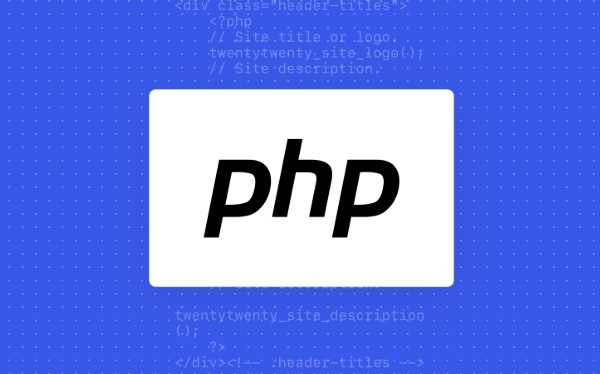It is recommended to use the DateTime class to add a number of days to dates in PHP, with clear code and flexible functions. The DateTime class introduced in PHP 5.2 supports object-oriented operations. The example code is: $date = new DateTime('2024-10-01'); $date->modify(' 5 days'); echo $date->format('Ym-d'); The output result is 2024-10-06; this method is highly readable and supports time zone setting and formatting output. You can also use strtotime() to implement it, but you need to pay attention to time zone issues. The example is: $newDate = date("Ymd", strtotime(" 5 days", strtotime($originalDate)); The same result is output, but it is recommended to use date_default_timezone_set() to ensure consistency. When processing dates with time, the DateInterval object should be used to accurately control the offset, such as $date->add(new DateInterval('P2D')); it can also be processed across months and New Year's Eve, but the time part will not be automatically truncated, and additional processing is required for switching daylight saving time. Summary: Stritotime() is available for simple scenarios. For complex requirements, it is recommended to use DateTime class or class library such as Carbon to improve reusability and maintenance.

Adding days to dates is a very common operation in PHP, especially when processing functions such as orders, event time, or user registration validity period. It is actually not difficult to implement, but there are several details that need to be paid attention to to avoid plagiarism.

Using the DateTime class is the most recommended way
PHP 5.2 began to introduce the DateTime class, which is more object-oriented than the old strtotime() and is easier to deal with complex date logic.

$date = new DateTime('2024-10-01'); $date->modify(' 5 days'); echo $date->format('Ym-d'); // Output: 2024-10-06
The advantage of this method is that it has strong readability and supports more format input and output, such as time zone settings, formatted output, etc.
If you need to process dates frequently, it is recommended to encapsulate them into functions or use a class library (such as Carbon), which can improve the reusability and maintainability of your code.

It can also be implemented using strtotime() , but pay attention to time zone issues
Although strtotime() is a more traditional approach, it is still easy to use in simple scenarios:
$originalDate = "2024-10-01";
$newDate = date("Ymd", strtotime(" 5 days", strtotime($originalDate)));
echo $newDate; // Output: 2024-10-06However, this method is easily affected by the server's default time zone, which may lead to deviations in the results. For example, if the original date does not specify a time explicitly, it may be that the time zone conversion will cause "adding a day" to be not the result you expected.
It is recommended to always use
date_default_timezone_set()to set the time zone to ensure consistency.
Be careful when dealing with dates with time
If you not only deal with "pure dates", you also include specific times, such as:
$date = new DateTime('2024-10-01 14:30:00'); $date->add(new DateInterval('P2D')); // Add two days echo $date->format('Ymd H:i:s'); // Output: 2024-10-03 14:30:00
Here, the DateInterval object is used to represent "two days". This method is very useful when accurately controlling time offsets, especially when it can be automatically handled across months and New Year's Eve.
But note:
- The time part will not be automatically cut off
- Additional processing may be required if daylight saving time switching is involved
Let's summarize
In general, the most recommended way to add days to dates in PHP is to use DateTime class, which is clear and flexible. If you just do simple operations, strtotime() is enough, but remember to pay attention to time zone issues. When encountering complex needs, such as time, cross-time zones, periodic calculations, etc., it is recommended to use class libraries to simplify work.
Basically all is it, not complicated but it is easy to ignore details.
The above is the detailed content of php add days to date. For more information, please follow other related articles on the PHP Chinese website!

Hot AI Tools

Undress AI Tool
Undress images for free

Undresser.AI Undress
AI-powered app for creating realistic nude photos

AI Clothes Remover
Online AI tool for removing clothes from photos.

Clothoff.io
AI clothes remover

Video Face Swap
Swap faces in any video effortlessly with our completely free AI face swap tool!

Hot Article

Hot Tools

Notepad++7.3.1
Easy-to-use and free code editor

SublimeText3 Chinese version
Chinese version, very easy to use

Zend Studio 13.0.1
Powerful PHP integrated development environment

Dreamweaver CS6
Visual web development tools

SublimeText3 Mac version
God-level code editing software (SublimeText3)

Hot Topics
 php regex for password strength
Jul 03, 2025 am 10:33 AM
php regex for password strength
Jul 03, 2025 am 10:33 AM
To determine the strength of the password, it is necessary to combine regular and logical processing. The basic requirements include: 1. The length is no less than 8 digits; 2. At least containing lowercase letters, uppercase letters, and numbers; 3. Special character restrictions can be added; in terms of advanced aspects, continuous duplication of characters and incremental/decreasing sequences need to be avoided, which requires PHP function detection; at the same time, blacklists should be introduced to filter common weak passwords such as password and 123456; finally it is recommended to combine the zxcvbn library to improve the evaluation accuracy.
 PHP Variable Scope Explained
Jul 17, 2025 am 04:16 AM
PHP Variable Scope Explained
Jul 17, 2025 am 04:16 AM
Common problems and solutions for PHP variable scope include: 1. The global variable cannot be accessed within the function, and it needs to be passed in using the global keyword or parameter; 2. The static variable is declared with static, and it is only initialized once and the value is maintained between multiple calls; 3. Hyperglobal variables such as $_GET and $_POST can be used directly in any scope, but you need to pay attention to safe filtering; 4. Anonymous functions need to introduce parent scope variables through the use keyword, and when modifying external variables, you need to pass a reference. Mastering these rules can help avoid errors and improve code stability.
 How to handle File Uploads securely in PHP?
Jul 08, 2025 am 02:37 AM
How to handle File Uploads securely in PHP?
Jul 08, 2025 am 02:37 AM
To safely handle PHP file uploads, you need to verify the source and type, control the file name and path, set server restrictions, and process media files twice. 1. Verify the upload source to prevent CSRF through token and detect the real MIME type through finfo_file using whitelist control; 2. Rename the file to a random string and determine the extension to store it in a non-Web directory according to the detection type; 3. PHP configuration limits the upload size and temporary directory Nginx/Apache prohibits access to the upload directory; 4. The GD library resaves the pictures to clear potential malicious data.
 Commenting Out Code in PHP
Jul 18, 2025 am 04:57 AM
Commenting Out Code in PHP
Jul 18, 2025 am 04:57 AM
There are three common methods for PHP comment code: 1. Use // or # to block one line of code, and it is recommended to use //; 2. Use /.../ to wrap code blocks with multiple lines, which cannot be nested but can be crossed; 3. Combination skills comments such as using /if(){}/ to control logic blocks, or to improve efficiency with editor shortcut keys, you should pay attention to closing symbols and avoid nesting when using them.
 How Do Generators Work in PHP?
Jul 11, 2025 am 03:12 AM
How Do Generators Work in PHP?
Jul 11, 2025 am 03:12 AM
AgeneratorinPHPisamemory-efficientwaytoiterateoverlargedatasetsbyyieldingvaluesoneatatimeinsteadofreturningthemallatonce.1.Generatorsusetheyieldkeywordtoproducevaluesondemand,reducingmemoryusage.2.Theyareusefulforhandlingbigloops,readinglargefiles,or
 Tips for Writing PHP Comments
Jul 18, 2025 am 04:51 AM
Tips for Writing PHP Comments
Jul 18, 2025 am 04:51 AM
The key to writing PHP comments is to clarify the purpose and specifications. Comments should explain "why" rather than "what was done", avoiding redundancy or too simplicity. 1. Use a unified format, such as docblock (/*/) for class and method descriptions to improve readability and tool compatibility; 2. Emphasize the reasons behind the logic, such as why JS jumps need to be output manually; 3. Add an overview description before complex code, describe the process in steps, and help understand the overall idea; 4. Use TODO and FIXME rationally to mark to-do items and problems to facilitate subsequent tracking and collaboration. Good annotations can reduce communication costs and improve code maintenance efficiency.
 Quick PHP Installation Tutorial
Jul 18, 2025 am 04:52 AM
Quick PHP Installation Tutorial
Jul 18, 2025 am 04:52 AM
ToinstallPHPquickly,useXAMPPonWindowsorHomebrewonmacOS.1.OnWindows,downloadandinstallXAMPP,selectcomponents,startApache,andplacefilesinhtdocs.2.Alternatively,manuallyinstallPHPfromphp.netandsetupaserverlikeApache.3.OnmacOS,installHomebrew,thenrun'bre
 Learning PHP: A Beginner's Guide
Jul 18, 2025 am 04:54 AM
Learning PHP: A Beginner's Guide
Jul 18, 2025 am 04:54 AM
TolearnPHPeffectively,startbysettingupalocalserverenvironmentusingtoolslikeXAMPPandacodeeditorlikeVSCode.1)InstallXAMPPforApache,MySQL,andPHP.2)Useacodeeditorforsyntaxsupport.3)TestyoursetupwithasimplePHPfile.Next,learnPHPbasicsincludingvariables,ech






